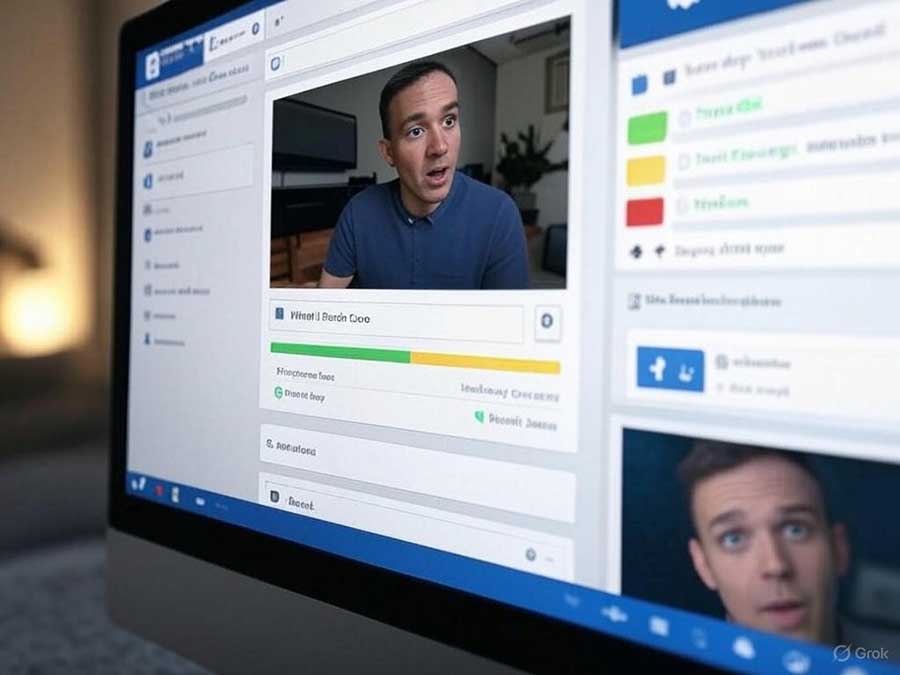
Faceoff Technologies (FO AI) technology can infer its potential role based on its described function as a multi-model AI Engine ,Adaptive Cognito Engine (ACE) is a mobile-optimized AI platform for real-time inference, integrating multimodal models for data extraction and adversarial robustness.
It has designed for deepfake detection and trust factor assessment. It can improve efficiency for Facebook (Meta) users, particularly in the context of the TAKE IT DOWN Act and Meta’s content ecosystem:
1. Streamlined Content Verification:
o Role of Faceoff: FO AI reportedly analyzes images and videos to detect deepfakes, assigning a trust factor score to indicate authenticity. For Meta users, integrating this technology into Facebook’s interface could provide real-time or near-real-time analysis of shared content.
o Efficiency Gain: Users would spend less time manually assessing content credibility. For example, a trust factor score displayed alongside videos or images could instantly signal whether content is likely manipulated, reducing the cognitive load of evaluating sources or comments. This aligns with Meta’s focus on user experience efficiency, as seen in its AI-driven content recommendation systems.
o TAKE IT DOWN Act Synergy: The Act mandates rapid removal of non-consensual content. Faceoff’s detection could flag deepfakes for review, accelerating compliance with the 48-hour removal requirement and minimizing user exposure to harmful material.

2. Enhanced User Safety and Trust:
o Role of Faceoff: By identifying deepfakes, FO AI could help users avoid engaging with or sharing malicious content, such as non-consensual explicit imagery targeted by the TAKE IT DOWN Act.
o Efficiency Gain: Users gain confidence in the platform, reducing time spent reporting or avoiding suspicious content. For instance, a trust factor score could deter users from interacting with low-trust posts, streamlining their feed to prioritize authentic content. This supports Meta’s Community Standards, which prioritize safety and authenticity.
o TAKE IT DOWN Act Synergy: The Act requires platforms to provide victim-friendly reporting systems. Faceoff’s proactive detection could reduce the burden on users to identify and report deepfakes, enhancing Meta’s responsiveness to victim requests.
3. Reduced Content Moderation Overload:
o Role of Faceoff: FO AI could assist Meta’s content moderation teams by pre-screening uploads for potential deepfakes, prioritizing high-risk content for human review.
o Efficiency Gain: With over 3 billion monthly active users on Facebook, manual moderation is resource-intensive. Automating deepfake detection would reduce the volume of content requiring human intervention, allowing moderators to focus on complex cases. This aligns with Meta’s “year of efficiency” initiatives, which emphasize cost-effective operations.
o TAKE IT DOWN Act Synergy: Faster identification of nonconsensual deepfakes ensures compliance with the Act’s removal timeline, improving platform accountability and user trust.
4. Empowering User Decision-Making:
o Role of Faceoff: The trust factor score could be integrated into Meta’s UI, such as a badge or tooltip on posts, enabling users to quickly gauge content reliability.
o Efficiency Gain: Users could filter or prioritize content based on trust scores, customizing their feed to avoid low-trust material. This reduces time spent navigating misinformation or harmful content, enhancing engagement with meaningful interactions—a priority for Meta’s algorithm since 2018.
o TAKE IT DOWN Act Synergy: By empowering users to avoid non-consensual deepfakes, Faceoff supports the Act’s goal of minimizing harm from exploitative content.
5. Integration with Meta’s AI Ecosystem:
o Role of Faceoff: Meta is heavily investing in AI, with models like Llama 4 and tools for content moderation and ad optimization. FO AI technology could complement these efforts, potentially integrating with Meta’s AI assistant or content recommendation systems to flag deepfakes.
o Efficiency Gain: A unified AI approach would streamline Meta’s infrastructure, reducing the need for disparate tools. For users, this means a seamless experience where deepfake detection is embedded in their interaction with Facebook, from feed browsing to ad engagement.
o TAKE IT DOWN Act Synergy: Leveraging Meta’s AI capabilities with Faceoff’s detection could enhance platform-wide compliance, ensuring rapid identification and removal of nonconsensual content across Facebook, Instagram, and WhatsApp.
6. Faceoff’s Technical Edge and Integration Framework
o Deployment & Privacy Architecture: Faceoff operates exclusively via a client-hosted API, ensuring no video content ever leaves the organization’s infrastructure. All processing occurs locally—within the enterprise cloud or data center. Faceoff has zero access to video frames, metadata, or features. Only anonymized usage logs (e.g., number of API calls) are reported for licensing. Its stateless, non-persistent design ensures inherent compliance with GDPR, HIPAA, and CCPA.
o Scalability & Performance: Faceoff’s API is microservice-based and stateless, enabling seamless horizontal scaling across GPUs or distributed inference engines. It supports near-real-time performance and can be embedded into edge workflows, mobile uploads, or ingestion servers.
o Integration for Meta-Scale Platforms: Faceoff integrates flexibly across moderation pipelines: Real-time scoring during uploads; Batch analysis for influencer streams or flagged content; Moderator dashboards with Explainable AI overlays; Automated escalation systems aligned with policy frameworks like the TAKE IT DOWN Act.
Challenges and Considerations
- Technical Integration: Integrating FO AI into Meta’s vast ecosystem requires compatibility with existing algorithms and infrastructure. Meta’s shift to AI-driven content moderation suggests feasibility, but scaling Faceoff’s multi-model AI to handle Facebook’s volume could be resource-intensive.
- User Privacy: Deepfake detection involves analyzing user-uploaded content, raising privacy concerns. Meta’s history of data privacy scrutiny (e.g., GDPR fines) necessitates transparent implementation to maintain user trust.
- False Positives: AI detection may misclassify authentic content as deepfakes, potentially frustrating users. Faceoff’s trust factor score must be refined to minimize errors and provide clear explanations.
- Adoption Barriers: Meta’s business model relies on ad revenue (97.8% of total revenue in 2023), and prioritizing deepfake detection could impact content virality. Collaboration with Faceoff’s FO AI .
Critical Perspective
While Meta’s content amplification drives engagement, it can exacerbate the spread of deepfakes, as seen in past controversies over misinformation. The TAKE IT DOWN Act addresses this by enforcing accountability, but relying solely on legislation may be insufficient without technological solutions. FO AI detection offers a proactive approach, but its effectiveness depends on Meta’s willingness to prioritize user safety over algorithmic reach. The opposition from Reps. Massie and Burlison highlights concerns about overregulation, suggesting that voluntary adoption of technologies like Faceoff could balance innovation with responsibility.
FO AI deepfake detection technology could significantly enhance efficiency for Meta users by streamlining content verification, improving safety, reducing moderation burdens, and empowering decision-making. Integrated with Meta’s AI ecosystem and aligned with the TAKE IT DOWN Act, it could create a safer, more efficient user experience.
However, successful implementation requires addressing technical, privacy, and commercial challenges. For more details on Meta’s AI initiatives, visit https://about.meta.com. For information on the TAKE IT DOWN Act, refer to official congressional records.
Faceoff Technologies Inc. (e.g., its AI models, processing speed, or integration capabilities) or want to explore a particular aspect (e.g., user interface design, cost implications).
The mock-up of how Faceoff’s trust factor score might appear in Facebook’s UI if you confirm you’d like an image.

See What’s Next in Tech With the Fast Forward Newsletter
Tweets From @varindiamag
Nothing to see here - yet
When they Tweet, their Tweets will show up here.



























